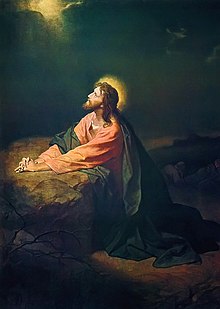Agony in the Garden

The Agony in the Garden refers to the events in the life of Jesus between the Last Supper and Jesus' arrest.[1]
Jesus' struggle (Greek agonia) praying and discussing with God, before accepting his sacrifice, before his arrest in the Garden of Gethsemane also denotes a state of mind - agony.
Scriptural depiction
According to all four Gospels, immediately after the Last Supper, Jesus took a walk to pray (John 18:1). Matthew and Mark identify this place of prayer as Gethsemane. Jesus was accompanied by St. Peter, St. John and St. James the Greater, whom he asked to stay awake and pray. He moved "a stone's throw away" from them, where he felt overwhelming sadness and anguish, and said "My Father, if it is possible, let this cup pass me by. Nevertheless, let it be as you, not I, would have it." Then, a little while later, He said, "If this cup cannot pass by, but I must drink it, your will be done!" (Matthew 26:42). He said this prayer three times, checking on the three apostles, between each prayer and finding them asleep. He comments: "The spirit is willing, but the flesh is weak". An angel came from heaven to strengthen him. During his agony, as he prayed "his sweat was as it were great drops of blood falling down upon the ground".(Luke 22:44).
Tradition

The Agony in the Garden is the first Sorrowful Mystery of the Rosary and the Second Station of the Scriptural Way of The Cross. The Roman Catholic tradition includes specific prayers and devotions as acts of reparation for the sufferings of Jesus during His Agony and Passion. These Acts of Reparation to Jesus Christ do not involve a petition for a living or dead beneficiary, but aim to repair the sins against Jesus. Some such prayers are provided in the Raccolta Catholic prayer book (approved by a Decree of 1854, and published by the Holy See in 1898) which also includes prayers as Acts of Reparation to the Virgin Mary.[2][3][4][5]
In his encyclical Miserentissimus Redemptor on reparations, Pope Pius XI called Acts of Reparation to Jesus Christ a duty for Catholics and referred to them as "some sort of compensation to be rendered for the injury" with respect to the sufferings of Jesus.[6]
Catholic tradition holds it that the sweating of blood was literal and not figurative.[7]
Holy Hour
In the Catholic tradition, Matthew 26:40 is the basis of the Holy Hour devotion for Eucharistic adoration.[8] In the Gospel of Matthew, Jesus spoke to his disciples, saying "My soul is sorrowful even to death. Remain here and keep watch with me." (Matthew 26:38) Returning to the disciples after prayer, he found them asleep and in Matthew 26:40 he asked Peter:
- "So, could you men not keep watch with me for an hour?".[8]
The tradition of the Holy Hour devotion goes back to 1673 when Saint Margaret Mary Alacoque stated that she had a vision of Jesus in which she was instructed to spend an hour every Thursday night to meditate on the sufferings of Jesus in the Garden of Gethsemane.[9][10][11]
Artistic depictions
See also
Notes
- ^ Bible Exposition Commentary, Vol. 1: New Testament by Warren W. Wiersbe 1992 ISBN 1-56476-030-8 pages 268-269
- ^ Catholic Encyclopedia http://www.newadvent.org/cathen/12775a.htm
- ^ Catholic Encyclopedia http://www.newadvent.org/cathen/12620a.htm
- ^ Joseph P. Christopher et al., 2003 The Raccolta St Athanasius Press ISBN 978-0-9706526-6-9
- ^ Ann Ball, 2003 Encyclopedia of Catholic Devotions and Practices ISBN 0-87973-910-X
- ^ Miserentissimus Redemptor Encyclical of Pope Pius XI http://www.vatican.va/holy_father/pius_xi/encyclicals/documents/hf_p-xi_enc_08051928_miserentissimus-redemptor_en.html
- ^
 Herbermann, Charles, ed. (1913). "Agony of Christ". Catholic Encyclopedia. New York: Robert Appleton Company.
Herbermann, Charles, ed. (1913). "Agony of Christ". Catholic Encyclopedia. New York: Robert Appleton Company.
- ^ a b Peter Stravinskas, 1998, Our Sunday Visitor's Catholic Encyclopedia, OSV Press ISBN 0-87973-669-0 page 498
- ^ Ann Ball, 2003 Encyclopedia of Catholic Devotions and Practices ISBN 0-87973-910-X page 240
- ^ The Westminster Dictionary of Christian Spirituality by Gordon S. Wakefield 1983 ISBN 0-664-22170-X page 347
- ^
 Herbermann, Charles, ed. (1913). "St. Margaret Mary Alacoque". Catholic Encyclopedia. New York: Robert Appleton Company.
Herbermann, Charles, ed. (1913). "St. Margaret Mary Alacoque". Catholic Encyclopedia. New York: Robert Appleton Company.
